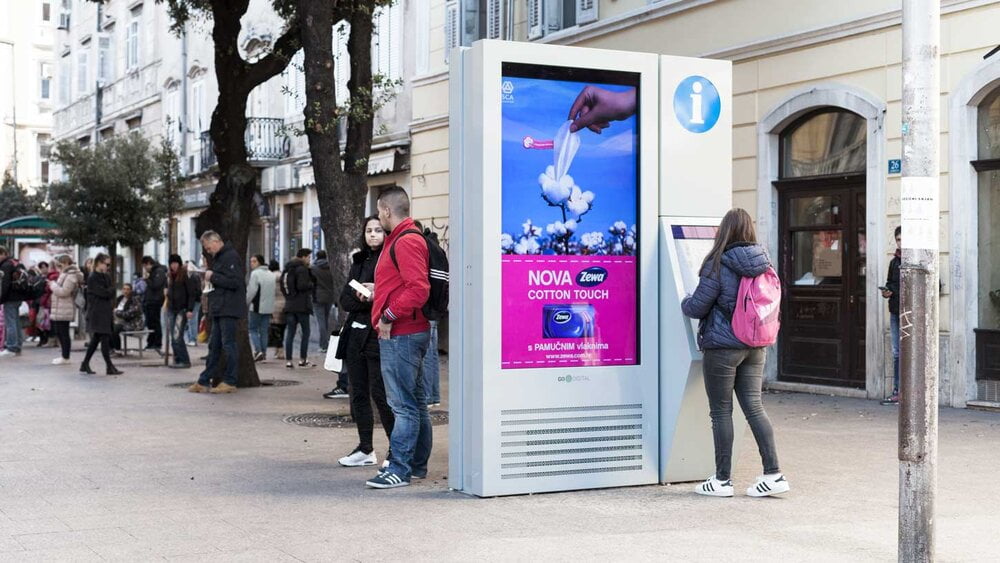In today’s world where technology has become an inseparable part of human life, companies are always in search of new opportunities to communicate with consumers. Digital signage is one of the most revolutionary technologies that have been used in advertising and information display. Although indoor digital signage has been common for quite some time now, “digital signage exterior” is becoming increasingly popular as a dynamic solution for outdoor spaces. From increasing the brand awareness to sharing the information in real time, the outdoor digital signage is becoming an indispensable tool for companies and organizations.
This blog explores the advantages, uses, technology and future trends of exterior digital signage and how it is transforming outdoor advertising and communication.
What is Exterior Digital Signage?
Outdoor digital signs are electronic signs that are positioned outside and are often installed in the public domain to display information in the form of text, images or videos. These displays are durable, and are suitable for use in outdoor environments, which are exposed to factors such as rain, dust and temperature changes. These signs usually use high-definition images, moving images, graphics and even buttons to draw the attention of the public.
While the traditional billboards are usually static and one cannot change the content at will, the digital signage is dynamic, and the content can be changed remotely. Whether it is used for advertising, public information or event information, exterior digital signage can be programmed to display a large number of messages that a company or organization may require.
Advantages of Exterior Digital Signage
1. High Visibility and Engagement
Among the key advantages of using digital signage in outdoor conditions, it is possible to highlight the possibility of attracting people’s attention. Lively and high-definition displays with moving images are seen in areas with heavy traffic such as downtowns, shopping centers, airports, and sports venues. It is impossible not to notice that people tend to look more at the moving and bright objects, which makes the electronic advertising displays more effective than the static ones, like billboards or posters. Due to the capability of displaying video, animated content or even text scroll, outdoor digital signs are very useful in capturing the attention of the target audience.
2. Real-Time Content Updates
Exterior digital signage has the advantage of having content changed at any time. This feature is especially valuable for companies that must respond to the dynamic environment, for instance, restaurants that can post new offers for the day or stores that can offer limited-time promotions. Also, during emergencies, it can display important information like evacuation directions or weather alerts, for instance. The feature that allows the content to be changed depending on the situation makes it more appropriate for broadcasting since the displayed message will always be timely.
3. Cost-Effectiveness Over Time
It is a capital-intensive investment in the sense that costs of buying digital signs is high but the overall benefits in the long run are immense. The conventional billboards or posters are static and need to be replaced and put up again each time a new message is to be displayed. On the other hand, digital signage does not require the expenses on printing and the changes can be made easily by a few clicks. In the long run, the ability to update content remotely results in cutting down on costs of operations.
4. Versatility
Another key benefit that can also be attributed to the use of digital signage is flexibility. The exterior digital signage can be applied in different applications ranging from commercial advertisements, direction signs, social information, and event information. Furthermore, the content can be posted at different intervals of the day depending on the target market that the business is targeting. For example, a coffee shop may offer breakfast menu at the morning time, lunch menu at midday, and happy hour offers in the evening.
5. Environmental Impact
It also has the added advantage of minimizing the waste that comes with printed advertisements. Billboards, posters, and flyers are examples of conventional advertising materials which are usually discarded after their time of use is over. As a result of moving to digital solutions, companies can minimize the use of paper in their marketing and advertising campaigns and, thus, support the environmentally friendly advertising strategies.
Applications of Exterior Digital Signage
The uses for exterior digital signage span various industries, making it an incredibly versatile tool. Some common applications include:
1. Retail and Commercial Advertising
Exterior digital signs are frequently implemented in the retail sector for the purpose of advertising products, special offers, and sales. These signs are usually mounted at strategic locations such as outside a store, inside shopping malls or along busy streets and roads to attract customers into the stores with various offers. These signs can also be used by the retailers in order to enhance brand awareness through the attractive designs and the use of multimedia.
2. Public Transportation Hubs
Some of the locations that are suitable for the use of digital signage include airports, train stations and bus stops. Such hubs are usually crowded and people in transit can be provided with important information through digital screens such as departure and arrival times, changes in gate numbers or even service disruptions. Moreover, transportation hubs are perfect places for advertising since they provide a great opportunity to address a large audience with the help of bright digital banners.
3. Sports and Entertainment Venues
Stadiums and arenas are popular places that apply large format digital displays to attract the audience. From showing game scores and players’ statistics to advertising upcoming events and selling merchandise, exterior digital signage is an effective way of engaging and informing the viewers. This also presents a chance for the digital signage in these environments to be used in sponsorships and advertisements by other brands.
4. Smart Cities and Public Information
Since more and more cities are implementing smart city solutions, digital signage is being used to convey public information. Municipalities employ the use of outdoor digital signs to communicate with the public on traffic changes, road construction and other events. Some of the cities have gone further and have installed interactive kiosks for people to get maps, weather information and other information as they move around.
5. Hospitality and Tourism
To improve guests’ experiences, hotels, resorts, and tourist attractions can use exterior digital signage. These include directional signs, welcome messages, and advertisements for services and facilities offered in the premises such as restaurants and other forms of entertainment. Also, digital signs in areas of interest for tourists can assist in guiding the visitors to certain areas and give information on issues such as ticketing or events time and schedules.
Technology Behind Exterior Digital Signage
1. High-Resolution Displays
Today’s outdoor digital signage comes with LED or LCD screens with high resolution to enable the content displayed to be easily viewed regardless of the light conditions. These displays are intended to produce good quality images, bright colors and legible text that can be easily viewed from a distance.
2. Weather-Resistant Design
Since exterior digital signage is installed outside, it has to be constructed in a way that it can be able to withstand extreme weather conditions. These enclosures are usually made of materials that are strong and hard wearing like stainless steel or aluminum and are designed in such a way that they are enclosed to avoid any ingress of water, dust or any other debris that may be detrimental to the electronic components. Some displays also come with in-built temperature control systems to make sure that the display keeps on working effectively in very high or low temperatures.
3. Remote Content Management
The majority of the outdoor digital signage systems come with content management software (CMS) where the user is able to manage and alter the content to be displayed. Cloud-based CMS solutions also allow for easy management of the displays as one can make changes from any location, and this makes it easier to schedule and edit the content that is to be displayed. The software also has the feature of making decisions based on data for instance identifying which adverts are most effective, or when to present specific content.
4. Energy Efficiency
Due to the increasing concern on energy use, today’s digital signage is equipped with energy-saving features like LED backlight and power save mode. This minimizes the adverse effects on the environment and also lowers the overall expenses of digital signage hence making it more sustainable in the future.
Challenges and Considerations
However, like any other form of advertising, exterior digital signage has its own set of problems. It may be costly at the beginning and most of the time, the installation demands technical skills. Another factor that businesses must also take into consideration is vandalism although many digital signage units are made with protective glass or other similar materials.
Also, it is crucial to consider the legal requirements of the country or locality with regard to outdoor advertising. Certain cities have certain restrictions on where, how bright and how long the digital signage content can be displayed in order to prevent causing distractions or creating visual pollution in certain areas.
Future Trends in Exterior Digital Signage
With the advancement in technology, exterior digital signage is projected to become more and more interactive as well as specific. The application of artificial intelligence and machine learning can make a digital sign to change its content depending on the audience, their behavior or even an event. For instance, a sign could detect people and change the message depending on people’s preferences or it could display messages such as weather alerts.
It is also expected that more and more interactive features, including touch screens and mobile applications, will be used. These features will enable the users to interact with the signage in a more direct manner and hence improve the customers’ satisfaction.
Conclusion
Outdoor advertising is changing with the introduction of exterior digital signs. This is because it has the ability to show real-time information and that is why it is very useful for business, government and even cities. Due to the development of technology and its availability, the future of the outdoor digital signage is bright and full of new possibilities, opportunities for higher level of engagement and interactivity.





